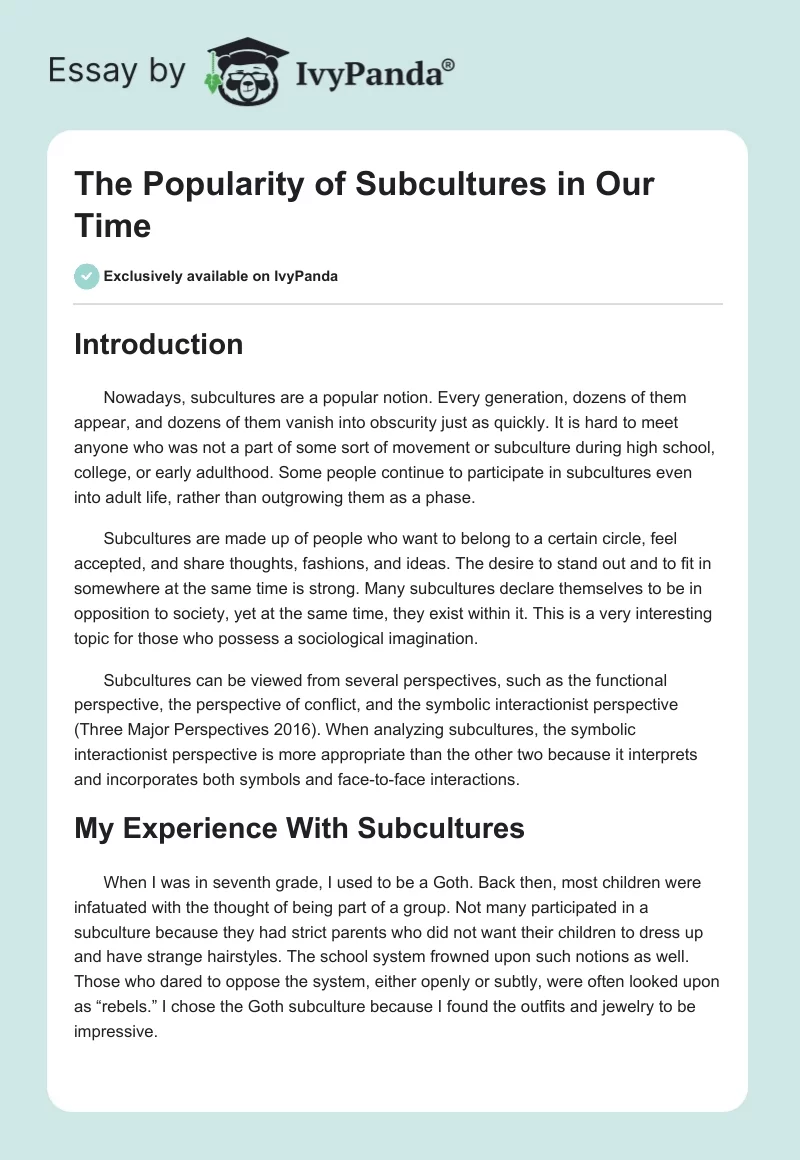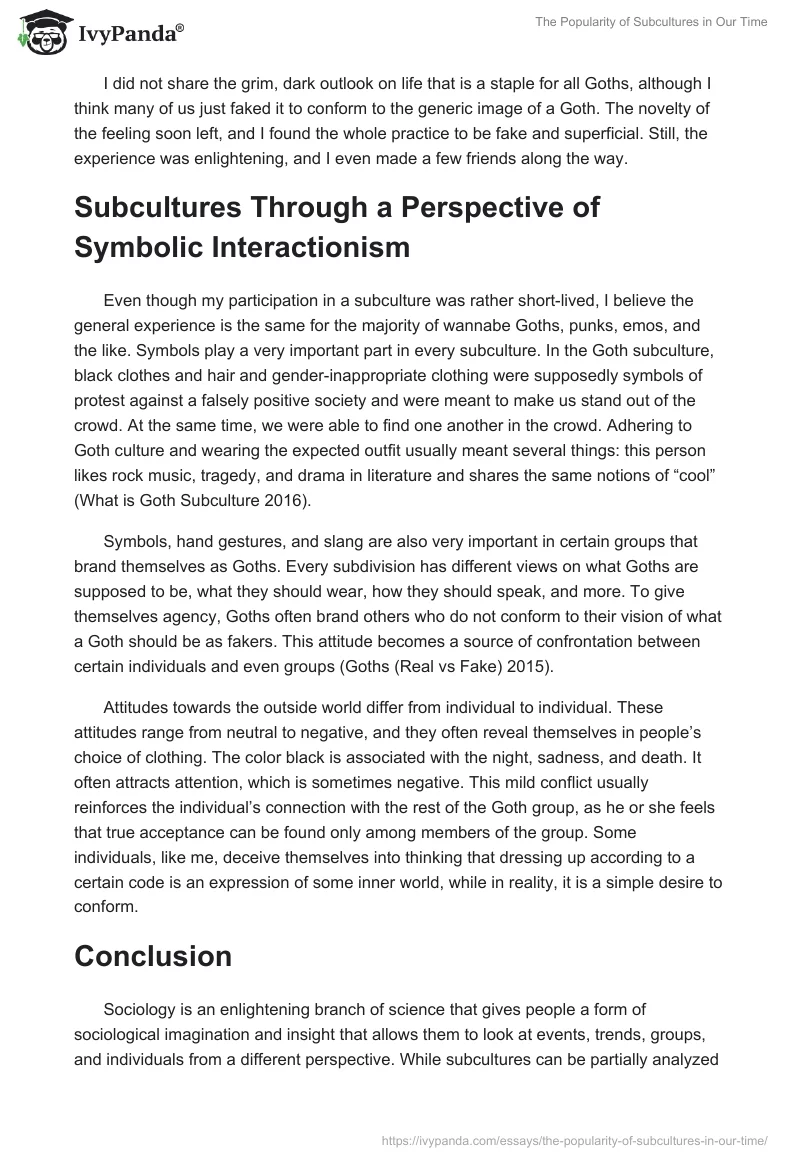Introduction
Nowadays, subcultures are a popular notion. Every generation, dozens of them appear, and dozens of them vanish into obscurity just as quickly. It is hard to meet anyone who was not a part of some sort of movement or subculture during high school, college, or early adulthood. Some people continue to participate in subcultures even into adult life, rather than outgrowing them as a phase.
Subcultures are made up of people who want to belong to a certain circle, feel accepted, and share thoughts, fashions, and ideas. The desire to stand out and to fit in somewhere at the same time is strong. Many subcultures declare themselves to be in opposition to society, yet at the same time, they exist within it. This is a very interesting topic for those who possess a sociological imagination.
Subcultures can be viewed from several perspectives, such as the functional perspective, the perspective of conflict, and the symbolic interactionist perspective (Three Major Perspectives 2016). When analyzing subcultures, the symbolic interactionist perspective is more appropriate than the other two because it interprets and incorporates both symbols and face-to-face interactions.
My Experience With Subcultures
When I was in seventh grade, I used to be a Goth. Back then, most children were infatuated with the thought of being part of a group. Not many participated in a subculture because they had strict parents who did not want their children to dress up and have strange hairstyles. The school system frowned upon such notions as well. Those who dared to oppose the system, either openly or subtly, were often looked upon as “rebels.” I chose the Goth subculture because I found the outfits and jewelry to be impressive.
I did not share the grim, dark outlook on life that is a staple for all Goths, although I think many of us just faked it to conform to the generic image of a Goth. The novelty of the feeling soon left, and I found the whole practice to be fake and superficial. Still, the experience was enlightening, and I even made a few friends along the way.
Subcultures Through a Perspective of Symbolic Interactionism
Even though my participation in a subculture was rather short-lived, I believe the general experience is the same for the majority of wannabe Goths, punks, emos, and the like. Symbols play a very important part in every subculture. In the Goth subculture, black clothes and hair and gender-inappropriate clothing were supposedly symbols of protest against a falsely positive society and were meant to make us stand out of the crowd. At the same time, we were able to find one another in the crowd. Adhering to Goth culture and wearing the expected outfit usually meant several things: this person likes rock music, tragedy, and drama in literature and shares the same notions of “cool” (What is Goth Subculture 2016).
Symbols, hand gestures, and slang are also very important in certain groups that brand themselves as Goths. Every subdivision has different views on what Goths are supposed to be, what they should wear, how they should speak, and more. To give themselves agency, Goths often brand others who do not conform to their vision of what a Goth should be as fakers. This attitude becomes a source of confrontation between certain individuals and even groups (Goths (Real vs Fake) 2015).
Attitudes towards the outside world differ from individual to individual. These attitudes range from neutral to negative, and they often reveal themselves in people’s choice of clothing. The color black is associated with the night, sadness, and death. It often attracts attention, which is sometimes negative. This mild conflict usually reinforces the individual’s connection with the rest of the Goth group, as he or she feels that true acceptance can be found only among members of the group. Some individuals, like me, deceive themselves into thinking that dressing up according to a certain code is an expression of some inner world, while in reality, it is a simple desire to conform.
Conclusion
Sociology is an enlightening branch of science that gives people a form of sociological imagination and insight that allows them to look at events, trends, groups, and individuals from a different perspective. While subcultures can be partially analyzed through conflict theory or functionalism, the symbolic interactionism perspective works best at underlining and explaining them through an analysis of the symbols they use and the day-to-day interactions they have. For most subcultures, there is a very little actual conflict with society, and protests are not taken any further than wearing odd clothes and covering themselves in tattoos and piercings (Crossman 2016a).
From a functional point of view, those who belong to subcultures are not too different from the rest of the society; indeed, they still participate in its life, have jobs, and obey the law (Crossman 2016b). Through the prism of symbolic interactionism, however, it is possible to see the true motives hidden behind their words and actions, which include the desire to belong, to find friends with similar interests, and to stand out while still conforming to both the inner circle of the subculture and the rest of the society. Goth subculture is just like any other in that respect, the only difference being the choice of clothes and symbols, as well as the official philosophy, which everybody knows but nobody truly believes in (Crossman 2016c).
References
Crossman, Ashley. “Conflict Theory.” 2016a. Web.
Crossman, Ashley. “Functionalist Theory.” 2016b. Web.
Crossman, Ashley. “Symbolic Interaction Theory.” 2016c. Web.
“Goths (Real vs Fake)”. 2015. Web.
“Three Major Perspectives in Sociology.” 2016. Web.
“What is Goth Subculture?” 2016. Web.


